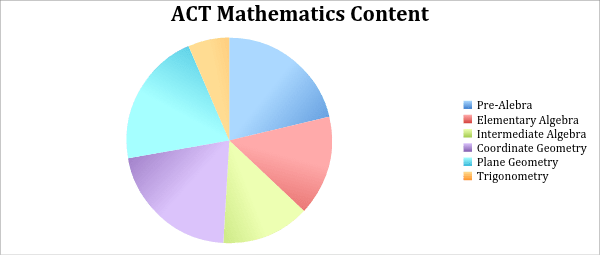
ACT Math Formulas
ACT math formulas, ACT math formula sheet, ACT equations
Perimeter, area and volume
Volume of a box:
Volume of a cube:
Surface area of a box:
Surface area of a cube:
Surface area: you add up all the faces
Diagonal of a box:
Diagonal of a cube:
The diagonal formula can be derived using the Pythagorean Theorem twice.
If a cube is inscribed in a sphere, the diagonal of the cube the diameter of the sphere.
Area of an equilateral triangle
Area of parallelogram
Area of a trapezoid: . Take the average of the 2 parallel bases and multiply by the perpendicular height.
Sum of interior angles of polygon
Angle of regular polygon or
Rhombus formula . Can be proved because the diagonals of a rhombus are perpendicular and the diagonals of a parallelogram bisect each other. Hence, we have 4 congruent triangles with are
.
In a Rhombus, the diagonals are perpendicular.
Perimeter of a rectangle .
Circumfrence of circle
Area of a circle
Volume of cylinder
Surface area of cylinder is
Trigonometry
To convert radians to degrees multiply by ; to convert degrees to radians, multiply by
.
and
around the circles; hence,
.
, which can be derived from the Pythagorean Theorem.
law of sines
law of cosines or
(laws of sines and cosines will be given, but you need to know how to use them) The law of sines works when you have an angle and an opposite side and one other piece of information. The law of cosines works in all other cases where you have 3 pieces of information: if you have 3 sides or 2 sides and the included angle. The laws of sines and cosines enable you to solve a triangle that is not a right triangle.
Coordinate geometry
Midpoint formula: . Take the average of the
s and
s to get the midpoint. This is a common problem and you only need to apply the formula.
Slope formula: , the change in
over the change in
.
Distance formula: , from the Pythagorean theorem.
If two lines are perpendicular, their slopes are negative reciprocals. For example, if a line has slope 3, the line perpendicular to it will have a slope .
Given a point and a slope m, the equation of the line is
. Alternatively
, and solve for b.
To reflect about the -axis, take the negative of the
-value; To reflect about the
-axis, take the negative of the
-value. This applies to both points and equations.
Slope of line in form is
. Get it into slope intercept form. By
.
The equation of a circle with center and radius
is
. For example, if the center is at (2, -5) and the radius is 3, the equation is
.
Averages
Need on test. If you have an 88 average of 5 tests, the way to find what you need on the test to average 90 is
.
Logic
Contrapositive: “All tables are flat” is the same as “If it is not a table, it is not flat”. Switch them and make them both not, and it is the same thing.
Combinations and permutations
Combinations: pick k of n: . Should only
, which is
. Can be done with combinations key of many calculators.
. For example
.
Permutations are rarer on the test. The difference between permutations and combinations is order matter for permutations. For example, picking a committee of 3 out of 10 is . Picking a President, Vice President and Treasurer of 10 is
. The formula for permutations is
. For example
is
is
.
Series and Sequences
sum of arithmetic series, is
. That is that the first and last elements, average them and multiply by the number of elements. For example the sum of all numbers to 100 is
.
sum of an infinite geometric series, , where r is the common ratio, the ratio of each element to the previous one. They should give you this formula.
For a geometric sequence, you may need to find a common ratio. For example, with the sequence 4, -6, 9, -13.5, the common ratio is -1.5; that is the ratio of each term to the preceding term. Therefore, the next term will be .
Complex Numbers
To rationalize the denominator of a complex number, multiply by the conjugate. The conjugate is the imaginary part made negative. The conjugate of is
. The conjugate of
is
. So
.
Multiplying a complex number by its conjugate always results in a real number.
Quadratic Equations
Sum of the roots of a quadratic, , is
.
Quadratic formula to solve is
.
Asymptotes
For a rational function, if the degree of the numerator and denominator are the same, the horizontal asymptote is the ratio of the highest order terms. If the denominator is of higher degree than the numerator, the horizontal asymptote is .
The vertical asymptotes are at any value that makes the denominator zero. For example, with , the vertical asymptotes are at
and
. The points
and
would also not be in the domain of the function.
Percentages
To find 23% of 70, .
23 is what percent of 70? .
23 is 70% of what? .
A 10% increase followed by a 20% increase is .
Triangles
In a triangle, the biggest angle is opposite the biggest side and the smallest angle is opposite the smallest side.
Triangle inequality: the sum of the length of 2 sides in always greater than the other side, since the shortest distance between 2 points is a straight line. Therefore if two sides have length a and b, the other side c is |a-b| < c < a+ b. For example, if two sides are 10 and 17, the other side is between 7 and 27.
30-60-90 and 45-45-90 triangles
In a 30-60-90 triangle, the side lengths are . In a 45-45-90 triangle, the side lengths are
.
A 30-60-90 triangle is half of an equilateral triangle. A 45-45-90 triangle is half of a square. The above ratios can both be derived using the Pythagorean Theorem.
Lots of test content.








The best guide to ACT math formulas, also known as ACT formula sheet and ACT equations. The math ACT provides no formulas, so it is best to study and memorize these formulas. Also pages on ACT math problems, an ACT math guide, and aCT math tutoring for 2020.
